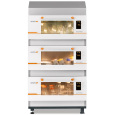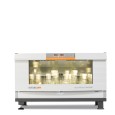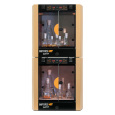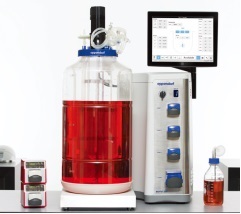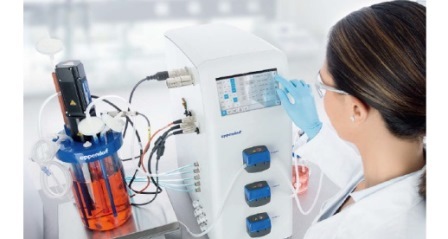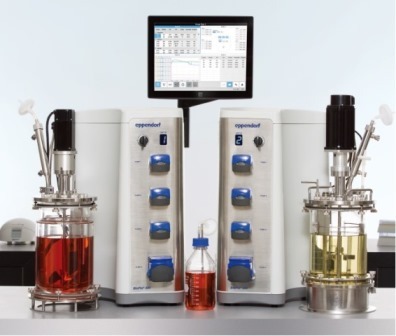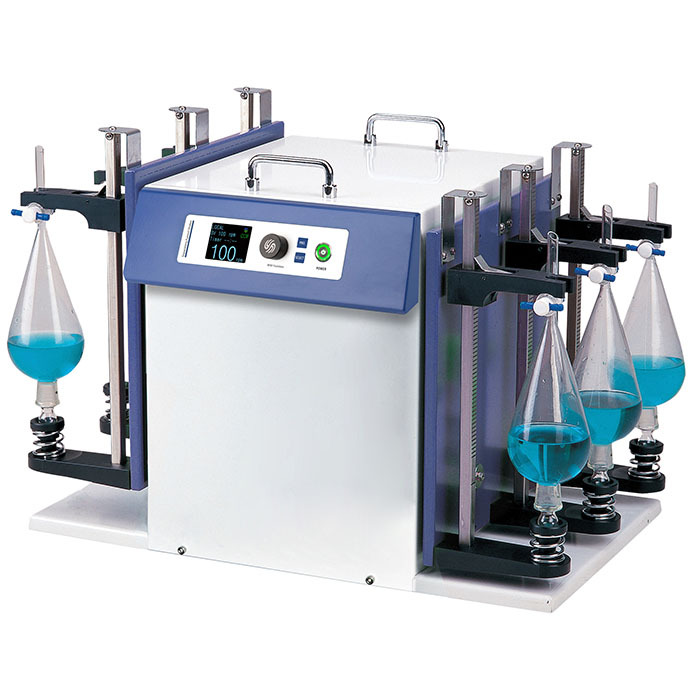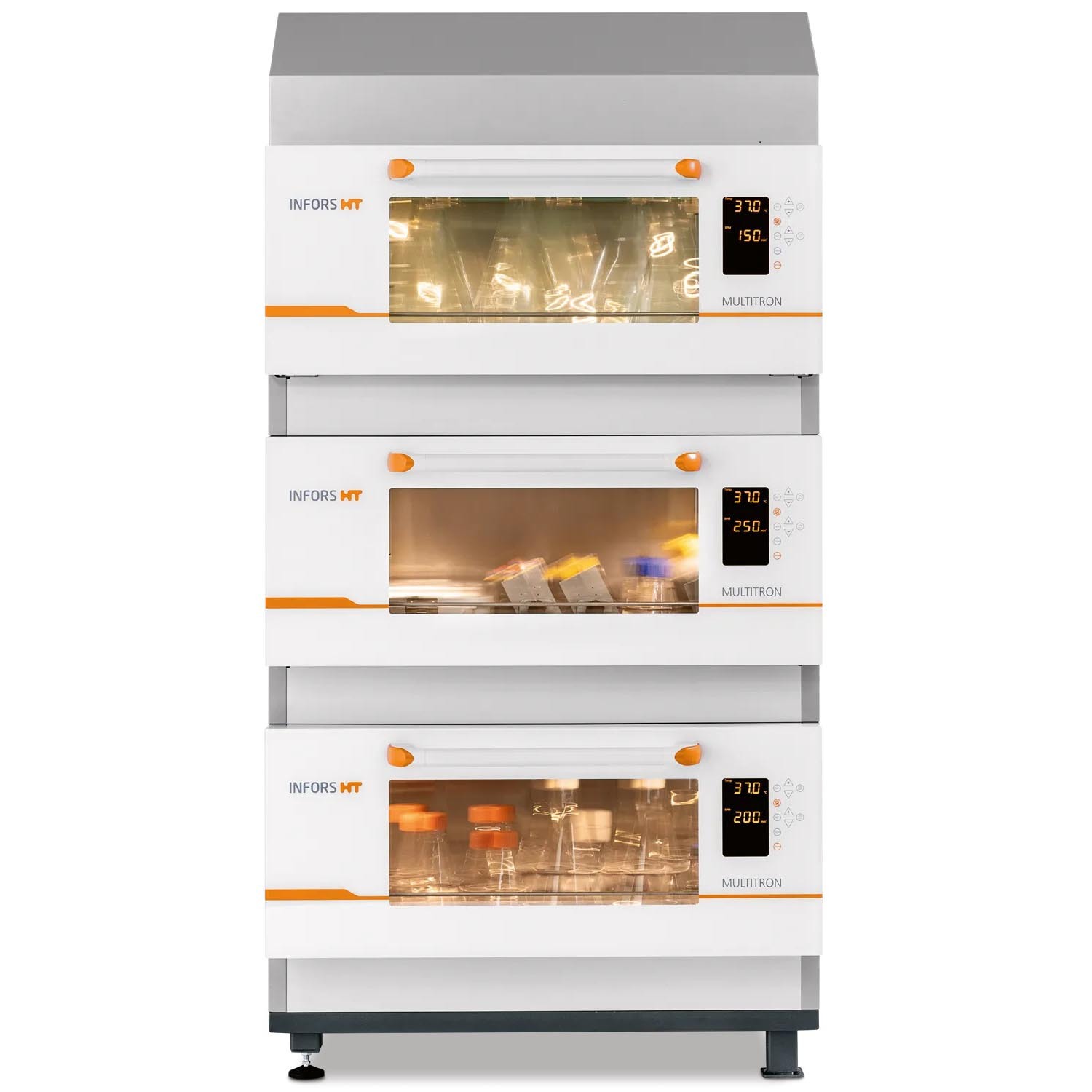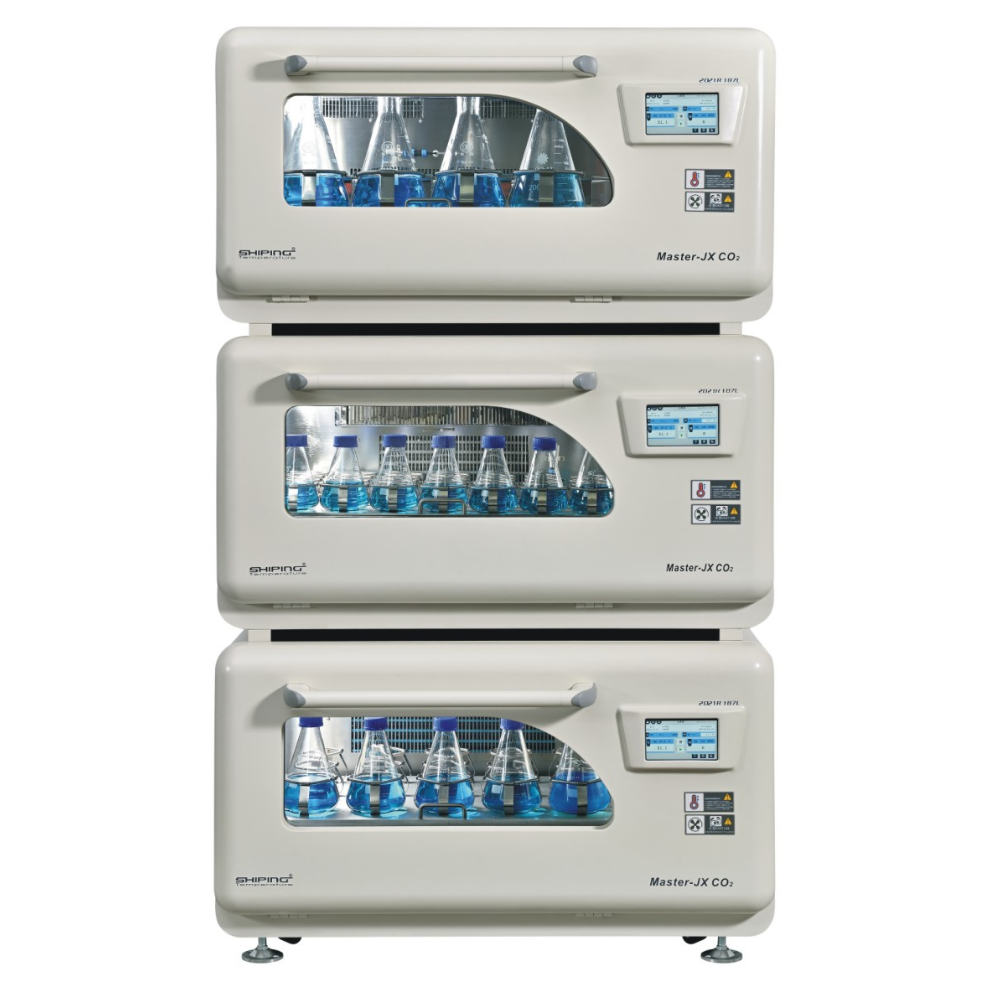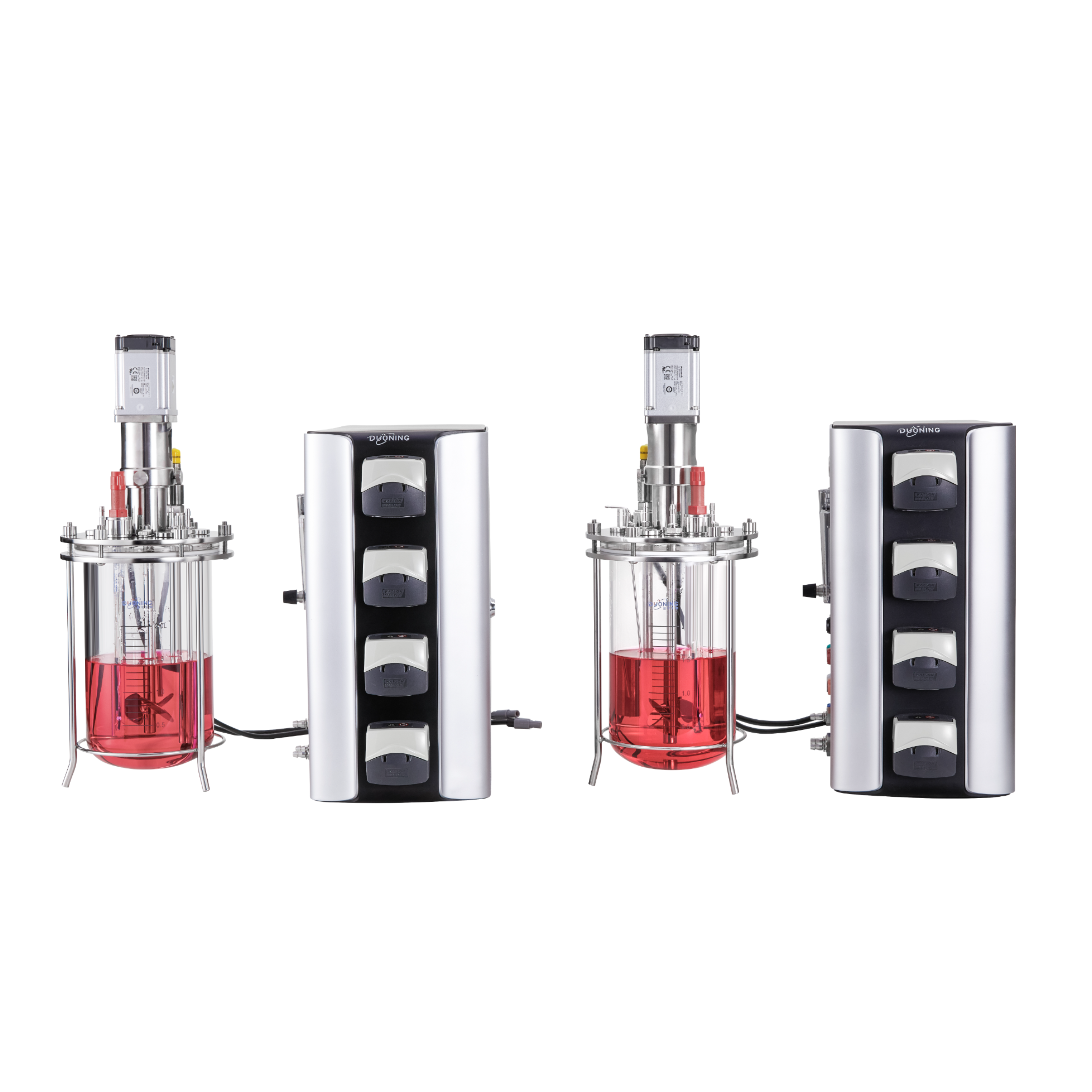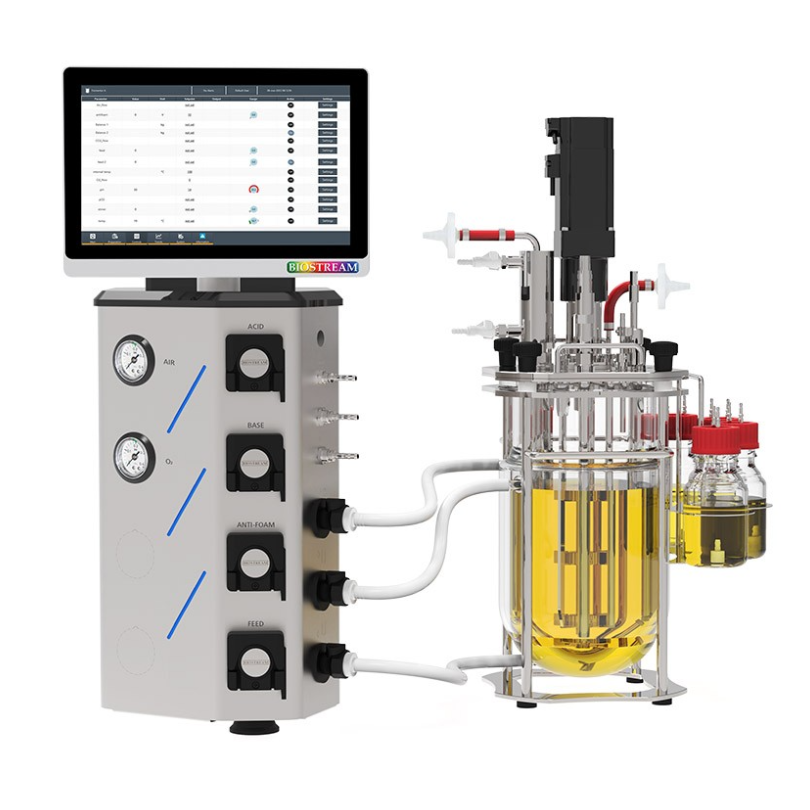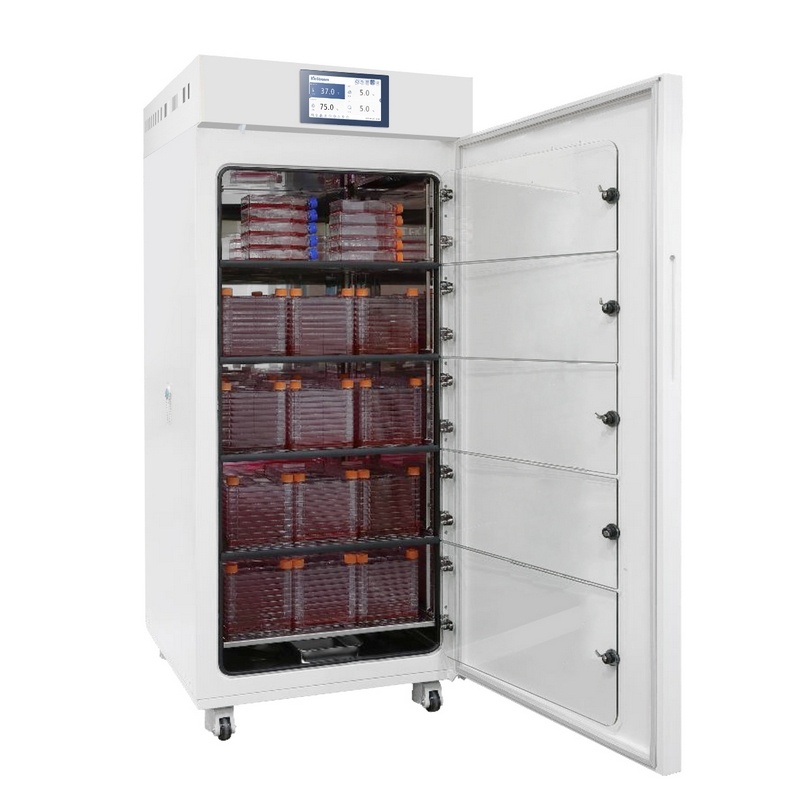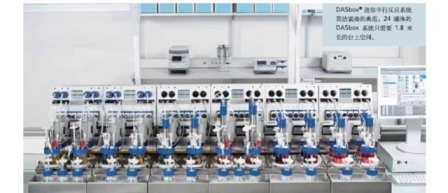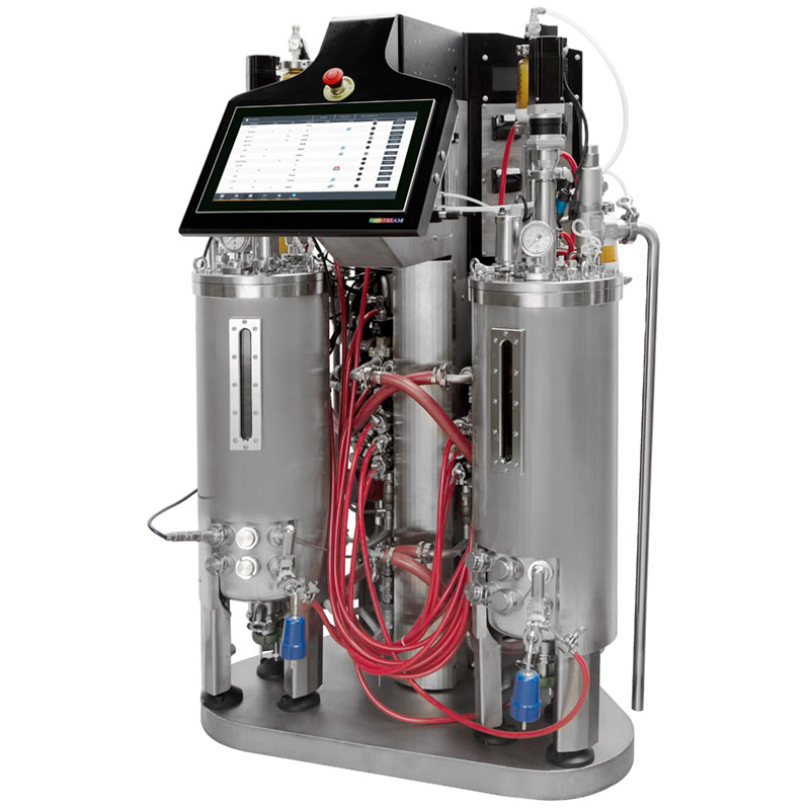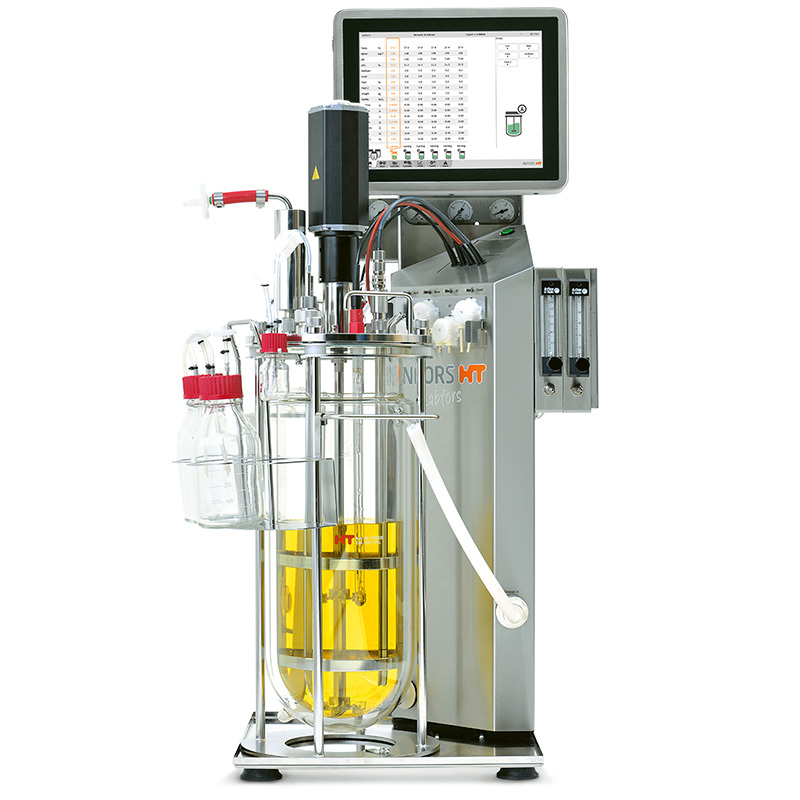
方案详情
文
曲霉菌在自然界广泛分布,可感染动物,也可寄生于饲料、粮食中引起动物中毒。常见有烟曲霉、黄曲霉、寄生曲霉、棕曲霉、杂色曲霉、构巢曲霉、白曲霉以及黑曲霉等,其中以烟曲霉感染致病为主,同时也可产生毒素,黄曲霉、寄生曲霉、棕曲霉、杂色曲霉等主要均以所产毒素而致病。
方案详情

发酵系统在曲霉菌培养中的应用曲霉菌在自然界广泛分布,可感染动物,也可寄生于饲料、粮食中引起动物中毒。常见有烟曲霉、黄曲霉、寄生曲霉、棕曲霉、杂色曲霉、构巢曲霉、白曲霉以及黑曲霉等,其中以烟曲霉感染致病为主,同时也可产生毒素,黄曲霉、寄生曲霉、棕曲霉、杂色曲霉等主要均以所产毒素而致病。 曲霉的菌丝分支分隔,分生孢子梗生长在足细胞上,不分支。顶端膨大呈圆形的顶囊,上着许多单层或双层的小梗,小梗着生分生孢子,孢子呈链状,可呈黄、绿、黑、灰等颜色。The fermenter is supplied in a configuration to provide an excellent bioreactor for this purpose. * Powerful, top drive system with lubricated mechanical seal (magnetic options for Techfors) * Jacketed system for efficient heat transfer. * High-accuracy pumps for addition of pH control reagents, antifoam and feed (option on some units) * Control of dissolved oxygen by stirrer speed as standard (air flow, pressure & oxygen, supplement options) * Optional analogue feed pump for variable speed additon * Analogue input/output for addition of external pumpsand sensros for eg. OD Vessels: All vessels are stainless steel (1.4435) with a dished base and top plate in several standard sizes. Temperature control can be by water circulation with either a heating element or steam injection into a pocket/exchanger.All vessels are with a mechanical seal drive (magnetic coupling for cells). The drive shaft has a simple and secure connection for the motor. The top plate is equipped with 10mm, PG13.5 and standard, rounded -thread 19mm ports which can be fitted with a septum and retaining collar to allow flaming of the port during inoculation etc. (number and type varies according to specific fermenter). Bottom ports are 25mm Ingold standard and numbers vary by size.The vessels are sterilized in situ (Techfors and Techfors S) with automatic sequencing. Reagent bottles and inlet pipes etc are usually autoclaved separately (options & alternatives, depending on size and configuration).. StirringThe fermenter has a powerful brushless motor with integral speed controller for speeds from 100 - 1500 rpm, depending on the vessel size and number of impellors. Powerful fluid cooled motors are standard for Techfors.x-DDC Control System:All fermenter models except Minifors incorporate the x-DDC (eXtended DDC microprocessor control) which uses a high-performance digital system. With the use of almost identical instrumentation, the step from Bench-scale to larger equipment is made considerably easier.The control panel is compact and is usually mounted above the base unit for clear visibility. The panel can be removed if required. Programming of parameters is via a splashproof keypad with a rotary knob for navigation and an LCD display. Communication is via a robust data-cable. For each fermenter, process information such as parameter set points, PID values etc are stored automatically on an interchangeable "memory card" . This allows changes in fermentation processes by fitting an alternative card or downloading a recipe without re-programming and the chance of errors plus an unlimited number of recipes to be stored.An "open frame" gas supply system with four magnetic valves allow addition of components for automatic mixing of gasses for oxygen supplementation. An optional mass flow control valve ensures a controlled, steady flow of gas into the vessel. Agitation & temperature control. Four high-accuracy digital peristaltic pumps supplied as standard with the option to add an integral analogue feed pump. Addition and removal of liquids is therefore possible with a standard system (using the antifoam pump for medium take-off). Accepts a conductive probe for automatic control of antifoam addition or media addition/removal in a vessel. Works together with the integral peristaltic pumps.Set points and control strategiesSet points are entered into the controller prior to inoculation and stored on a memory card (except Minifors). The vessel was allowed to equilibrate prior to inoculation. The pO2 actual value may stay above the set point up to (and some times after) inoculation.Temperature:28-32°CpH:5-5.6DO:30% Agitation:600 rpm+ .O2 :Optional supplementation of the air stream using a magnetic valve (rotameter)PH ControlThe pH probe is calibrated prior to the autoclave cycle (refer to fermenter Instruction Manual). pH control parameters are:Base: 2M NaOHAcid: 2M H3PO4Transfer tubing :Narrow bore silicone tubing with Marprene insert, as supplied (4mm OD)Vessel inlet :4mm fixed pipes in the vessel top platePID values: factory default setting should be used unless it is clear adjustment is needed (hunt or drift).Dissolved Oxygen (pO2) ControlThe dissolved oxygen electrode 100% is normally calibrated after the autoclave cycle (refer tto Instrucion Manual) but can be calibrated in air beforehand for cell culture applications. Control of pO2 can be cascaded eg rpm, airflow, gasmix (depending on options and fermenter type). The controller automatically maintains the pO2 setpoint. The gas flow rate should be set at a fairly low rate initially eg. 0.3 vessel volumes per minute (VVM) and raised incrementally during the fermentation to 1VVM (max. 1.5-2 VVM) whenever the stirrer cannot maintain the correct pO2 value (usually required within an hour or so).Fed-batch/Continuous FeedFeed pumps can be calibrated using the standard tubing to keep track of the liquid quantities entering and exiting the vessel. Either a digital pump with shot and delay dosing or an analogue, continuously-variable pump can be used for medium addition. Samples should be taken several times a day to measure parameters such as cell numbers, viability, carbon-source concentration etc). Iris v5 software can be used to control nutrient addition. Fed-batch does not involve removal of liquid.Feeding can be related to dissolved oxygen concentration by using software control sequences.Foam ControlThis can be achieved by adding a small quantity of antifoam into the medium before inoculation (eg. 0.005 -0.01%) and subsequently controlled by a liquid antifoam delivered on demand into the vessel (or at regular time intervals). An antifoam probe uses conductivity to detect the presence of foam. The clear sheathing around the probe should not be damaged or false positive readings will occur. Example methodologyMediumMolasses or YPG medium plus supplements. Use of antifoam in the medium can help suppress foaming. Supplements are filter sterilized and added after sterilization of the bulk medium in the vessel (10% loss of volume is typically experienced during the sterilization process; allow for this). InoculumPrepared in an Infors shaker (Minitron or Multitron) from a 24 hour culture of spores inoculated into 250ml shake flasks containing 50ml of medium. Shaker speed is 240rpm and a temperature 32oC. Use these to inoculate the fermenter as a 5%.by volume concentrate of actively growing cells.MethodElectrodes should have been calibrated before autoclaving (pH and zero point pO2).• Sterilize the vessel with the basic medium. Adjust for evaporation losses, if necessary.• Allow to cool to operating conditions and then calibrate pO2 100% value. • Add any supplements then inoculate using a syringe or transfer line. Take a To sample for pH, optical density and glucose measurement. Dry weight values can be related to optical density readings and total/viable counts as required. Sample at eg. 1 hour intervals to follow the process. After a lag phase of several hours a strong logarithmic growth should occur with substrate depletion unless fed-batch or continuous operation is implemented. The end of active growth may be marked by a rise in the dissolved oxygen concentration/decrease in stirrer speed. Typically, fermentations last up to 7 days.Aspergillus species are a diverse group, so only general guidelines can be provided as a starting point.发酵系统在曲霉菌培养中的应用 曲霉菌在自然界广泛分布,可感染动物,也可寄生于饲料、粮食中引起动物中毒。常见有烟曲霉、黄曲霉、寄生曲霉、棕曲霉、杂色曲霉、构巢曲霉、白曲霉以及黑曲霉等,其中以烟曲霉感染致病为主,同时也可产生毒素,黄曲霉、寄生曲霉、棕曲霉、杂色曲霉等主要均以所产毒素而致病。 曲霉的菌丝分支分隔,分生孢子梗生长在足细胞上,不分支。顶端膨大呈圆形的顶囊,上着许多单层或双层的小梗,小梗着生分生孢子,孢子呈链状,可呈黄、绿、黑、灰等颜色。 The fermenter is supplied in a configuration to provide an excellent bioreactor forthis purpose. * Powerful, top drive system with lubricated mechanical seal (magnetic options forTechfors) * Jacketed system for efficient heat transfer. * High-accuracy pumps for addition of pH control reagents, antifoam and feed(option on some units) * Control of dissolved oxygen by stirrer speed as standard (air flow, pressure &oxygen, supplement options) * Optional analogue feed pump for variable speed additon * Analogue input/output for addition of external pumpsand sensros for eg. OD Vessels: All vessels are stainless steel (1.4435) with a dished base and top plate in severalstandard sizes. Temperature control can be by water circulation with either aheating element or steam injection into a pocket/exchanger. All vessels are with a mechanical seal drive (magnetic coupling for cells). The driveshaft has a simple and secure connection for the motor. The top plate is equippedwith 10mm,PG13.5 and standard, rounded -thread 19mm ports which can be fittedwith a septum and retaining collar to allow flaming of the port during inoculationetc. (number and type varies according to specific fermenter). Bottom ports are25mm Ingold standard and numbers vary by size. The vesselsare sterilized iin situ (Techfors and Techfors S) with aauutomaticsequencing. Reagent bottles and inlet pipes etc are usually autoclaved separately(options & alternatives, depending on size and configuration).. Stirring The fermenter has a powerful brushless motor with integral speed controller forspeeds from 100-1500 rpm, depending on the vessel size and number of impellors.Powerful fluid cooled motors are standard for Techfors. x-DDC Control System: All fermenter models except Minifors incorporate the x-DDC (eXtended DDCmicroprocessor control) which uses a high-performance digital system. With theuse of almost identical instrumentation, the step from Bench-scale to largerequipment is made considerably easier. The control panel is compact and is usually mounted above the base unit for clearvisibility. The panel can be removed if required. Programming of parameters is via asplashproof keypad with a rotary knob for navigation and an LCD display. Communication is via a robust data-cable. For each fermenter, process informationsuch as parameter set points, PID values etc are stored automatically on aninterchangeable "memory card" . This allows changes in fermentation processes byfitting an alternative card or downloading a recipe without re-programming andthe chance of errors plus an unlimited number of recipes to be stored. An "open frame" gas supply system with four magnetic valves allow addition ofcomponents for automatic mixing of gasses for oxygen supplementation. Anoptional mass flow control valve ensures a controlled, steady flow of gas into thevessel. Agitation & temperature control. Four high-accuracy digital peristalticpumps supplied as standard with the option to add an integral analogue feedpump. Addition and removal of liquids is therefore possible with a standard system(using the antifoam pump for medium take-off). Accepts a conductive probe forautomatic control of antifoam addition or media addition/removal in a vessel.Works together with the integral peristaltic pumps. Set points and control strategies Set points are entered into the controller prior to inoculation and stored on amemory card (except Minifors). The vessel was allowed to equilibrate prior toinoculation. The pO2 actual value may stay above the set point up to (and sometimes after) inoculation. Temperature: 28-32℃ pH: 5-5.6 DO: 30% Agitation: 600 rpm+. O2 : Optional supplementation of the air stream using a magnetic valve (rotameter) PH Control The pH probe is calibrated prior to the autoclave cycle (refer to fermenterInstruction Manual). pH control parameters are: Base: 2M NaOH Acid: 2M H3PO4 Transfer tubing : Narrow bore silicone tubing with Marprene insert, as supplied(4mm OD) Vessel inlet : 4mm fixed pipes in the vessel top plate PID values: factory default setting should be used unless it is clear adjustment isneeded (hunt or drift). Dissolved Oxygen (pO2) Control The dissolved oxygen electrode 100% is normally calibrated after the autoclavecycle (refer tto Instrucion Manual) but can be calibrated in air beforehand for cellculture applications. Control of pO2 can be cascaded eg rpm, airflow, gasmix(depending on options and fermenter type). The controller automatically maintainsthe pO2 setpoint. The gas flow rate should be set at a fairly low rate initially eg. 0.3vessel volumes per minute (VVM) and raised incrementally during the fermentationto 1VVM (max. 1.5-2 VVM) whenever the stirrer cannot maintain the correct pO2value (usually required within an hour or so). Fed-batch/Continuous Feed Feed pumps can be calibrated using the standard tubing to keep track of the liquidquantities entering and exiting the vessel. Either a digital pump with shot and delaydosing or an analogue, continuously-variable pump can be used for mediumaddition. Samples should be taken several times a day to measure parameters suchas cell numbers, viability, carbon-source concentration etc). Iris v5 software can beused to control nutrient addition. Fed-batch does not involve removal of liquid.Feeding can be related to dissolved oxygen concentration by using softwarecontrol sequences. Foam Control This can be achieved by adding a small quantity of antifoam into the mediumbefore inoculation (eg. 0.005 -0.01%) and subsequently controlled by a liquidantifoam delivered on demand into the vessel (or at regular time intervals). Anantifoam probe uses conductivity to detect the presence of foam. The clearsheathing around the probe should not be damaged or false positive readings willOccur. Example methodology Medium Molasses or YPG medium plus supplements. Use of antifoam in the medium canhelp suppressfoaming. Supplements arefilter sterilized and added aftersterilization of the bulk medium in the vessel (10% loss of volume is typicallyexperienced during the sterilization process; allow for this). Inoculum Prepared in an Infors shaker (Minitron or Multitron) from a 24 hour culture ofspores inoculated into 250ml shake flasks containing 50ml of medium. Shakerspeed is 240rpm and a temperature 32oC. Use these to inoculate the fermenter as a5%.by volume concentrate of actively growing cells. Method Electrodes should have been calibrated before autoclaving (pH and zero point pO2). ·SSterilize the vessel with the basic medium. Adjust for evaporation losses, ifnecessary. · Allow to cool to operating conditions and then calibrate pO2 100% value. · Add any supplements then inoculate using a syringe or transfer line. Take a Tosample for pH, optical density and glucose measurement. Dry weight values can berelated to optical density readings and total/viable counts as required. Sample at eg.1 hour intervals to follow the process. After a lag phase of several hours a strong logarithmic growth should occur withsubstrate depletion unless fed-batch or continuous operation is implemented. Theend of active growth may be marked by arise in the dissolved oxygenconcentration/decrease in stirrer speed. Typically, fermentations last up to 7 days.Aspergillus species are a diverse group, so only general guidelines can be providedas a starting point.
确定

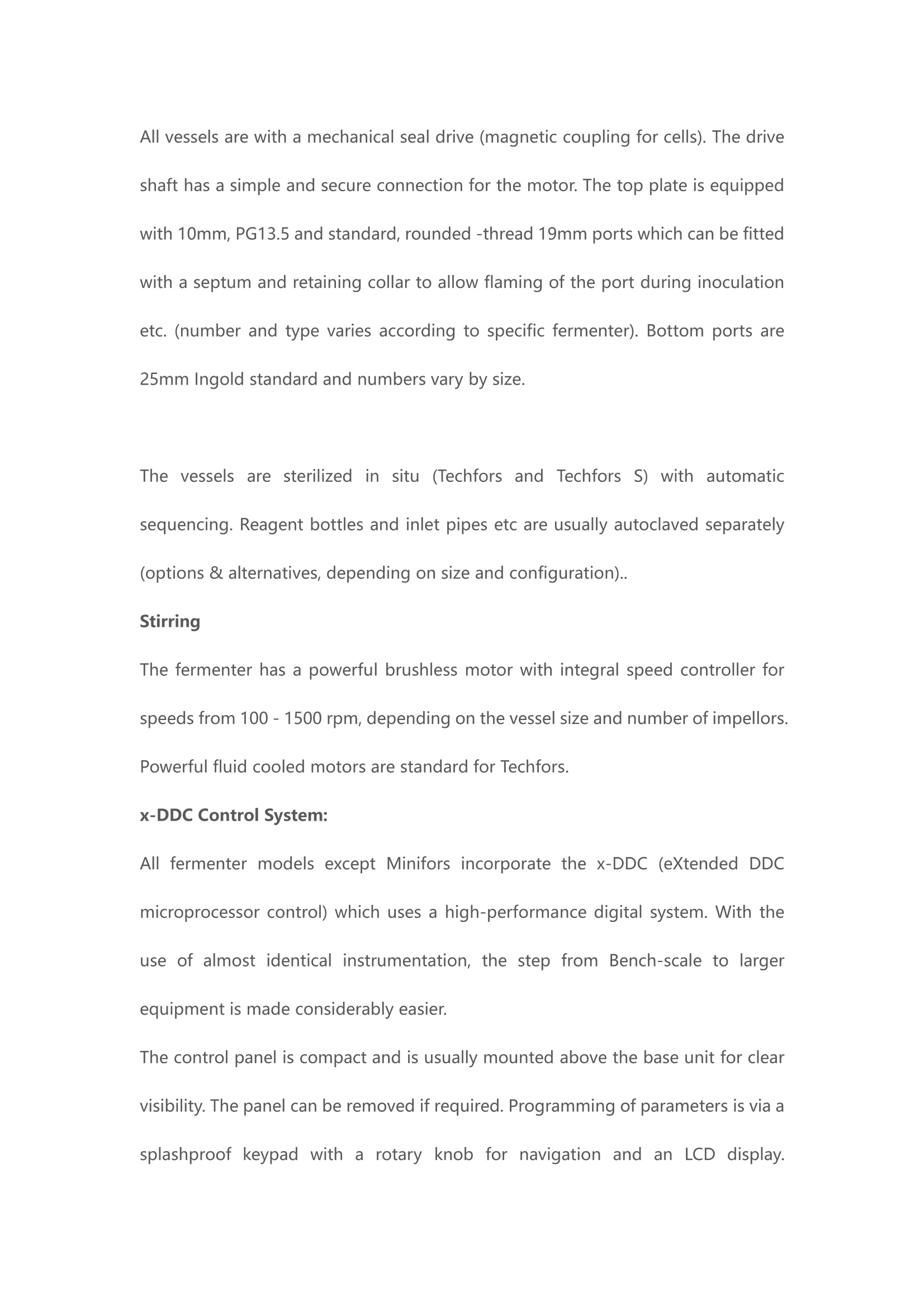
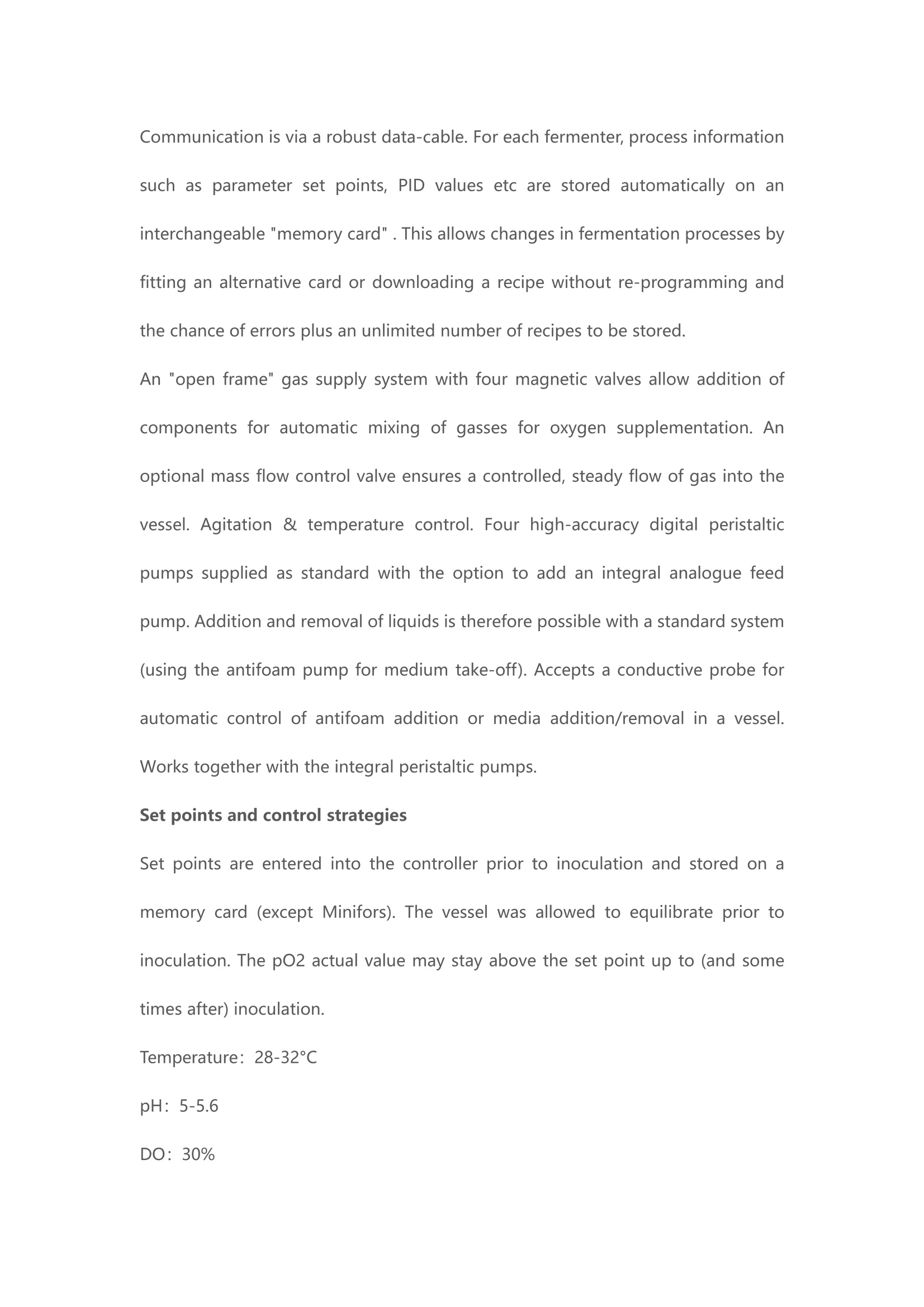
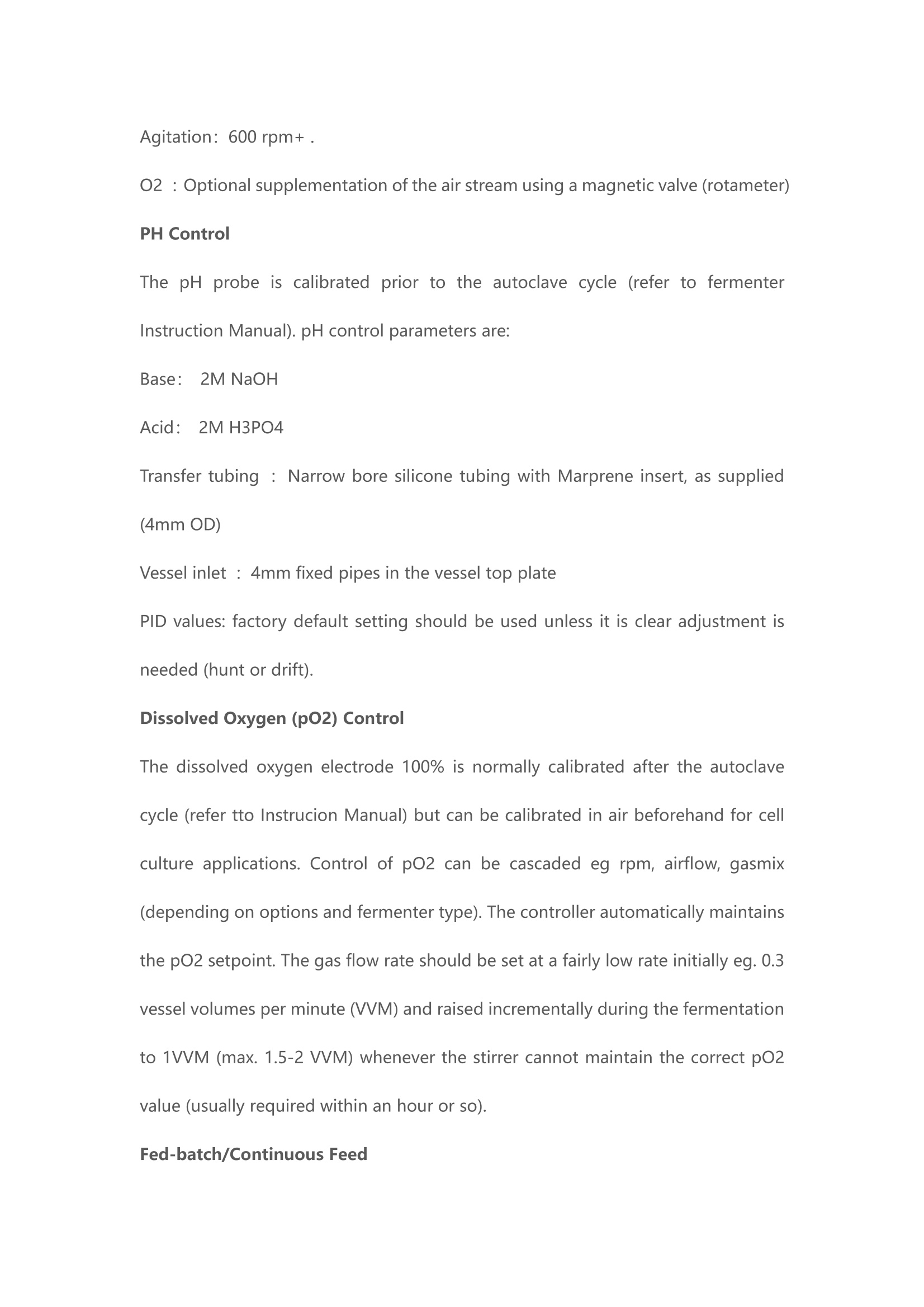

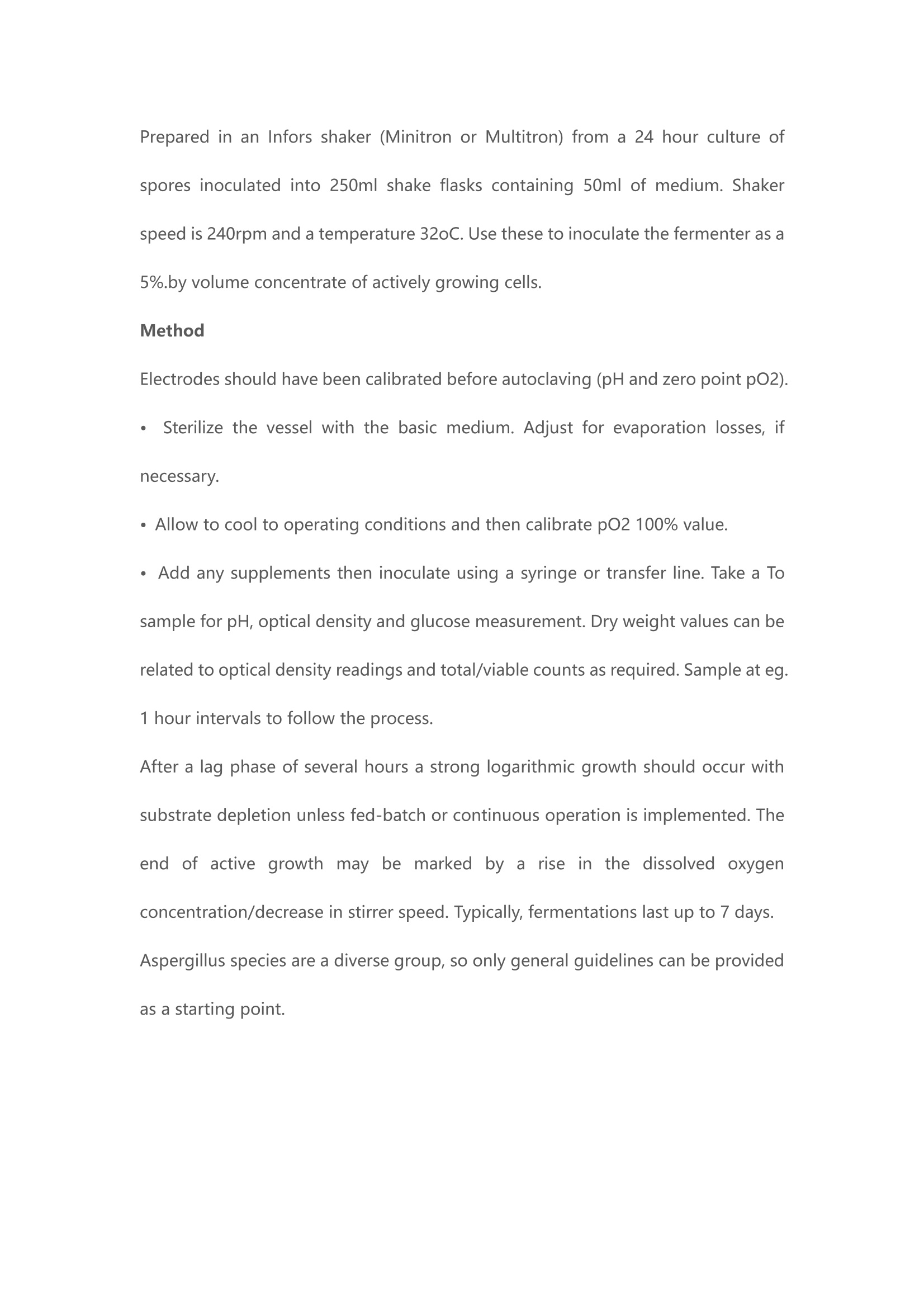
还剩4页未读,是否继续阅读?
北京桑翌实验仪器研究所为您提供《发酵系统在曲霉菌培养中的应用》,该方案主要用于生物发酵中应用介绍检测,参考标准--,《发酵系统在曲霉菌培养中的应用》用到的仪器有INFORS Labfors 5 台式发酵罐、INFORS Multitron 振荡培养箱(细胞工厂)、INFORS Multitron 95℃高温振荡培养箱、INFORS Ecotron振荡培养箱、INFORS Labfors Lux 平板LED光照发酵罐、INFORS Minifors 实验室台式标准发酵罐、INFORS Multifors平行生物反应器
推荐专场
相关方案
更多
该厂商其他方案
更多










